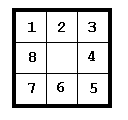
Fig. 5.2
The title of this section refers to a familiar and popular sliding tile puzzle that has been around for at least forty years. The most frequent older versions of this puzzle have numbers or letters an the sliding tiles, and the player is supposed to slide tiles into new positions in order to realign a scrambled puzzle back into a goal alignment. For illustration, we use the 3 x 3 8-tile version, which is depicted here in goal configuration

The moves are described for the puzzle solver in terms of which direction the empty tile appears to travel.goal(1/2/3/8/0/4/7/6/5).
The heuristic function we use here is a combination of two other estimators: p_fcn, the Manhattan distance function, and s_fcn, the sequence function, all as explained in Nilsson (1980), which estimates how badly out-of-sequence the tiles are (around the outside).left( A/0/C/D/E/F/H/I/J , 0/A/C/D/E/F/H/I/J ). left( A/B/C/D/0/F/H/I/J , A/B/C/0/D/F/H/I/J ). left( A/B/C/D/E/F/H/0/J , A/B/C/D/E/F/0/H/J ). left( A/B/0/D/E/F/H/I/J , A/0/B/D/E/F/H/I/J ). left( A/B/C/D/E/0/H/I/J , A/B/C/D/0/E/H/I/J ). left( A/B/C/D/E/F/H/I/0 , A/B/C/D/E/F/H/0/I ). up( A/B/C/0/E/F/H/I/J , 0/B/C/A/E/F/H/I/J ). up( A/B/C/D/0/F/H/I/J , A/0/C/D/B/F/H/I/J ). up( A/B/C/D/E/0/H/I/J , A/B/0/D/E/C/H/I/J ). up( A/B/C/D/E/F/0/I/J , A/B/C/0/E/F/D/I/J ). up( A/B/C/D/E/F/H/0/J , A/B/C/D/0/F/H/E/J ). up( A/B/C/D/E/F/H/I/0 , A/B/C/D/E/0/H/I/F ). right( A/0/C/D/E/F/H/I/J , A/C/0/D/E/F/H/I/J ). right( A/B/C/D/0/F/H/I/J , A/B/C/D/F/0/H/I/J ). right( A/B/C/D/E/F/H/0/J , A/B/C/D/E/F/H/J/0 ). right( 0/B/C/D/E/F/H/I/J , B/0/C/D/E/F/H/I/J ). right( A/B/C/0/E/F/H/I/J , A/B/C/E/0/F/H/I/J ). right( A/B/C/D/E/F/0/I/J , A/B/C/D/E/F/I/0/J ). down( A/B/C/0/E/F/H/I/J , A/B/C/H/E/F/0/I/J ). down( A/B/C/D/0/F/H/I/J , A/B/C/D/I/F/H/0/J ). down( A/B/C/D/E/0/H/I/J , A/B/C/D/E/J/H/I/0 ). down( 0/B/C/D/E/F/H/I/J , D/B/C/0/E/F/H/I/J ). down( A/0/C/D/E/F/H/I/J , A/E/C/D/0/F/H/I/J ). down( A/B/0/D/E/F/H/I/J , A/B/F/D/E/0/H/I/J ).
h_function(Puzz,H) :- p_fcn(Puzz,P),
s_fcn(Puzz,S),
H is P + 3*S.
The 'move' predicate is defined as follows.
Here is the code for p and s.move(P,C,left) :- left(P,C). move(P,C,up) :- up(P,C). move(P,C,right) :- right(P,C). move(P,C,down) :- down(P,C).
%%% Manhattan distance
p_fcn(A/B/C/D/E/F/G/H/I, P) :-
a(A,Pa), b(B,Pb), c(C,Pc),
d(D,Pd), e(E,Pe), f(F,Pf),
g(G,Pg), h(H,Ph), i(I,Pi),
P is Pa+Pb+Pc+Pd+Pe+Pf+Pg+Ph+Pg+Pi.
a(0,0). a(1,0). a(2,1). a(3,2). a(4,3). a(5,4). a(6,3). a(7,2). a(8,1).
b(0,0). b(1,0). b(2,0). b(3,1). b(4,2). b(5,3). b(6,2). b(7,3). b(8,2).
c(0,0). c(1,2). c(2,1). c(3,0). c(4,1). c(5,2). c(6,3). c(7,4). c(8,3).
d(0,0). d(1,1). d(2,2). d(3,3). d(4,2). d(5,3). d(6,2). d(7,2). d(8,0).
e(0,0). e(1,2). e(2,1). e(3,2). e(4,1). e(5,2). e(6,1). e(7,2). e(8,1).
f(0,0). f(1,3). f(2,2). f(3,1). f(4,0). f(5,1). f(6,2). f(7,3). f(8,2).
g(0,0). g(1,2). g(2,3). g(3,4). g(4,3). g(5,2). g(6,2). g(7,0). g(8,1).
h(0,0). h(1,3). h(2,3). h(3,3). h(4,2). h(5,1). h(6,0). h(7,1). h(8,2).
i(0,0). i(1,4). i(2,3). i(3,2). i(4,1). i(5,0). i(6,1). i(7,2). i(8,3).
%%% the out-of-cycle function
s_fcn(A/B/C/D/E/F/G/H/I, S) :-
s_aux(A,B,S1), s_aux(B,C,S2), s_aux(C,F,S3),
s_aux(F,I,S4), s_aux(I,H,S5), s_aux(H,G,S6),
s_aux(G,D,S7), s_aux(D,A,S8), s_aux(E,S9),
S is S1+S2+S3+S4+S5+S6+S7+S8+S9.
s_aux(0,0) :- !.
s_aux(_,1).
s_aux(X,Y,0) :- Y is X+1, !.
s_aux(8,1,0) :- !.
s_aux(_,_,2).
The Prolog program from the previous section (5.1) and the program outlined in this section can be used as an 8-puzzle solver.
The code for this section also contains a solution animator that is explained in Section 8.2.?- solve(0/8/1/2/4/3/7/6/5, S). S = [right, right, down, left, left, up, right, down] ; ...
Exercise 5.2.1 Add statistics to 'solve'; that is, return also the number of nodes expanded, and the number of nodes left on open (at end of a successful search). [Add any other statistics you feel might be interesting to see.]
Exercise 5.2.2 Look in the literature for an algorithm that decides, given a starting configuration S for the 8-puzzle, whether or not the goal G is reachable from S. (Half, 9!/2 = 181,440, will be reachable.) Implement this algorithm in Prolog.
Exercise 5.2.3 Modify the program to use f(n) = g(n) + p_fcn(n). These searches will result in optimal solutions (if one exists). Using the statistics of Exercise 5.2.1 above to make practical comparisons between solutions using h(n) = p_fcn(n)+3*s_fcn(n) and h(n) = p_fcn(n).